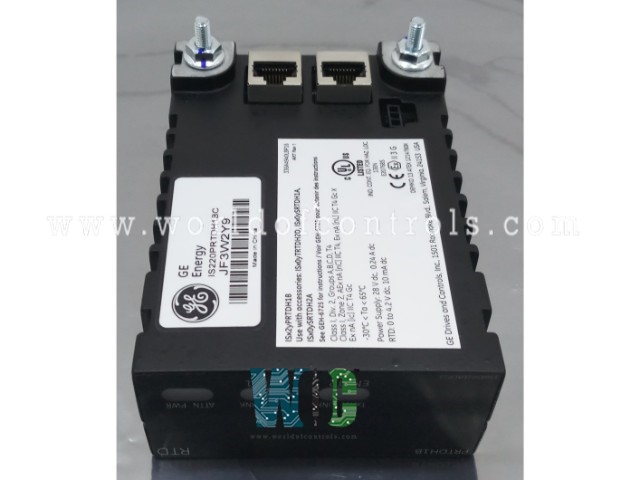SPECIFICATIONS
Part No.: IS220PRTDH1BF
Manufacturer: General Electric
Country of Manufacture: United States of America (USA)
Number of channels: 8
Span: 0.3532 to 4.054 V
A/D converter resolution: 14-bit resolution
Product Type: RTD Input Pack
Availability: In Stock
Series: Mark VIe
Functional Description
IS220PRTDH1BF is an RTD input pack developed by GE. It is a part of the Mark VIe system. The Resistance Temperature Device (RTD) Input (PRTD) pack serves as the electrical interface between one or two I/O Ethernet networks and an RTD input terminal board. This pack is a component in control systems, providing a reliable and accurate means of measuring temperature via RTDs.
Features
- Processor Board: The pack contains a common processor board for all Mark VIe distributed I/O packs. This standardized processor board ensures consistent performance and integration across different I/O packs, simplifying system maintenance and upgrades.
- Acquisition Board: Specific to the thermocouple input function, the acquisition board in the PRTD pack is designed to handle the unique requirements of RTD temperature measurements. It ensures precise data acquisition, which is critical for maintaining accurate temperature readings.
- RTD Input Capacity: The I/O pack is capable of handling up to eight RTD inputs directly. This makes it suitable for applications requiring multiple temperature measurement points.
- Extended Capacity with Terminal Boards: For applications needing even more temperature inputs, the PRTD pack can manage up to 16 RTD inputs when used in conjunction with TRTD terminal boards. This scalability is advantageous for larger systems where extensive temperature monitoring is necessary.
Installation
- Securely Mount the Terminal Board: First, choose an appropriate location for your terminal board and mount it securely. This prevents any movement or vibrations that could affect the connections and overall performance.
- Connect the PRTD Packs: Plug one or two PRTD packs directly into the terminal board connectors. Use one pack for simplex control of up to eight RTDs. If you need to control 16 RTDs, use two packs.
- Secure the Packs Mechanically: Utilize the threaded inserts adjacent to the Ethernet ports to secure the packs. Connect these inserts to a mounting bracket specific to your terminal board type. Adjust the bracket location to ensure there is no right-angle force applied to the DC-37 pin connector between the pack and the terminal board. This adjustment should only need to be done once in the life of the product.
- Connect the Ethernet Cables: Plug in one or two Ethernet cables, depending on your system configuration. If you are using dual connections, the standard practice is to connect ENET1 to the network associated with the R controller.
- Apply Power: Plug in the power connector on the side of the pack. The I/O pack features a soft-start capability that controls current inrush when power is applied, making it unnecessary to disconnect power from the cable before plugging it in.
- Configure the I/O Pack: After powering on the pack, configure it as necessary to meet your system requirements. This ensures the pack functions correctly and integrates seamlessly with your system.
Power Management
- The power management function includes a soft start feature. This feature controls the current inrush during power application, preventing sudden surges that could potentially damage the pack or connected components. The soft start ensures a smooth and gradual increase in power, enhancing the longevity and reliability of the system.
- After power is applied, the circuit incorporates a fast current limit function. This function acts as a protective measure, preventing any pack or terminal board failure from propagating back onto the 28 V power system. By limiting the current quickly, it helps to contain any issues within the affected pack or terminal board, safeguarding the rest of the system.
- When the power is present and functioning correctly, the green PWR indicator light will be illuminated. This provides a visual confirmation that the pack is receiving power and operating normally. If the current limit function is triggered due to a problem, the PWR indicator will turn off. This alerts the operator to an issue that needs to be addressed before normal operation can resume.
The WOC team can always help you with your Mark VIe requirements. For more information, please contact WOC.
Frequently Asked Questions
What is IS220PRTDH1BF?
It is an RTD input pack developed by GE under the Mark VIe series.
What is the purpose of the power management function in the pack?
The power management function in the pack is designed to enhance the reliability and protection of the 28 V input circuit. It controls current inrush during power application and prevents failures from propagating back onto the power system.
What is the soft start capability, and why is it important?
The soft start capability controls the current inrush when power is first applied to the pack. This prevents sudden surges that could damage the pack or connected components, ensuring a smooth and gradual increase in power. This feature enhances the longevity and reliability of the system.
How does the fast current limit function work?
The fast current limit function acts as a protective measure after power is applied. It quickly limits the current to prevent any pack or terminal board failure from affecting the rest of the 28 V power system. This containment helps safeguard the broader system from electrical issues.
